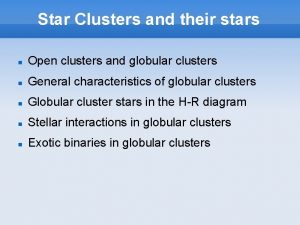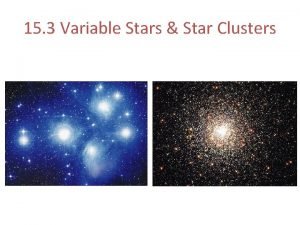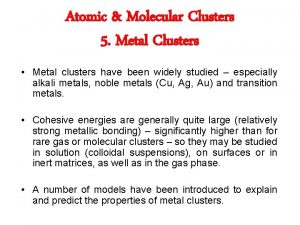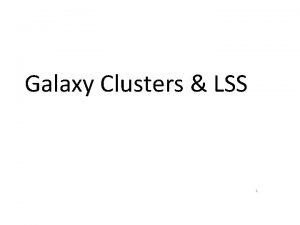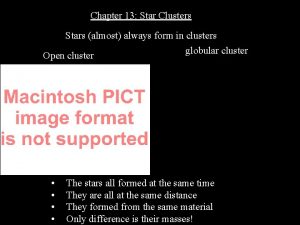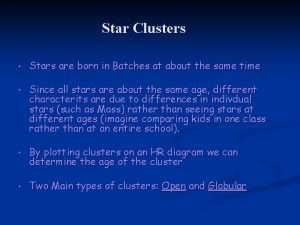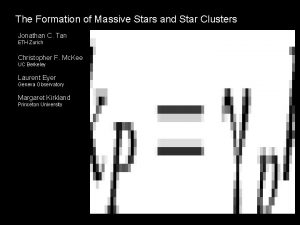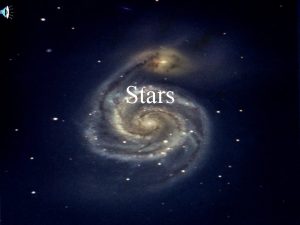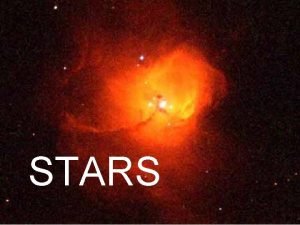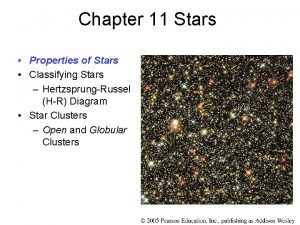Part 5 Review Groups of stars star clusters















- Slides: 15

Part 5: Review Groups of stars: star clusters: open and closed Milky Way galaxies: elliptical, spiral, irregular Cosmology: distance time Life: conditions probabilities travel

Star Clusters Open or galactic star clusters: a few dozen stars mainly young stars including O and B (blue) stars found in the galaxies arms Closed or globular star clusters: up to a million stars no young stars (only G thru M stars on main sequence) found in a spherical shell around the galaxy

Milky Way crosses the ecliptic near Sagittarius and near Gemini; bright stars include Sirius, Betelgeuse, Capella, Deneb, and Vega Spiral galaxy (type S-B barred) about 100, 000 light years across about 2, 000 light years thick with central bulge of radius 15, 000 light years has about 200, 000 stars has a super massive black hole at its center. Solar System is in one of the arms about half way to the edge (about 30, 000 light years from the center).

Galaxy Types Elliptical galaxies: giant with up to a trillion stars and 1 million light years in size and dwarf with down to just a million stars E-0 most round, E-7 most elliptical (football shaped) few if any young stars Spiral galaxies: only giant size regular and barred types type A: biggest with tightly wound arms type B: intermediate size with more loosely wound arms type C: smallest size with very loosely wound arms has young and blue (O and B) stars in the arms Irregular galaxies: only dwarf size has young and blue (O and B) stars

Clusters of Galaxies Regular clusters: Regular clusters have up to 10, 000 galaxies Irregular clusters: much smaller in number and size Local Group is an example which includes about 40 galaxies including: Milky Way (Spiral B galaxy) Andromeda Spiral B galaxy about 2, 000 light years from Milky Way Triangulum Spiral C galaxy about 3, 000 light years from Milky Way Large and Small Magellanic Clouds (irregular galaxies) about 179, 000 and 210, 000 light years from Milky Way The rest are dwarf ellipticals

Cluster of Clusters: Superclusters Rich Superclusters contain dozens of Clusters of Galaxies and are about 150 million light years across. Our Local Group of galaxies (an irregular, poor group) is part of a “poor” supercluster of galaxies centered on the Virgo rich regular cluster (the only rich regular cluster in our supercluster). Superclusters of galaxies are spread out in lines of superclusters that surround huge volumes of space with few galaxies in them. These voids are 100 to 400 million light years in diameter. Our location in the universe: We are on a planet 93, 000 miles from the center of our Solar system, in the middle of the arms of our giant galaxy 30, 000 light years from its center, which is part of a “poor” cluster of galaxies about 60, 000 light years from its center, which is part of a “poor” supercluster of galaxies.

Distance Determinations Distances: 1. Parallax based on trig gives distances out to about 300 light years 2. Stellar classifications give luminosities which when related to brightness gives distances out to several thousand light years 3. Cepheid variables based on the period-luminosity relation of these supergiant stars gives distances out to several million light years 4. Standard sizes of spiral galaxies gives standard luminosities of these giant galaxies along with brightness gives distances out to several hundred million light years. 5. Hubble’s Law that relates a galaxies red shift to its distance gives distances out to about 14 billion light years. 6. Gravitational Waves may give more accurate distances measurements.

Cosmology Possible hypotheses: 1. God created the universe and made it look the way it does. 2. Steady State: The universe had no beginning and no end. It is always the same (on average). 3. Big Bang: The universe started as a highly compacted mass and “exploded”. It is getting bigger due to the explosion. Data: 1. The night sky is dark. 2. The red shift indicates that all galaxies are moving away from one another. 3. Space itself has a temperature – about 3 K.

Cosmology Theories Possible hypotheses: 1. God created the universe and made it look the way it does. Problem: Possible but not scientific in that it is not falsifiable and it does not lead to new predictions. 2. Steady State: The universe had no beginning and no end. It is always the same (on average). Problem: Can’t explain 3 K background temperature. 3. Big Bang: The universe started as a highly compacted mass and “exploded”. It is getting bigger due to the explosion. Generally accepted theory

Big Bang Theory – Birth and Death of Universe Birth of Universe (initial moment of the Big Bang) Ways of determining this age: at least as old as the earth at least as old as the time it would take to make the heavy elements in stars at least as old as the globular (galactic) star clusters at least as old as the time it takes light to reach from the furthest galaxies. Best Estimate: 14 billion years old Death of the Universe May collapse after its expansion, or it may continue to expand without end. Dark mass and dark energy plays an important part.

Life in the Universe Life based on gravity: time scale probably too slow Life based on nuclear forces: time scale probably too fast Life based on chemical forces: this is what we have. Carbon is the best chemical due to its binding properties but silicon might be used with AI (robotic artificial intelligence) Water is the best liquid if the temperature allows, but other liquids are possible. Need stable environment (no extremes or sudden changes; even Earth has undergone several mass extinctions in the past) Based on trace elements, life did develop on earth (but may have started elsewhere and been transported to earth at very early stage)

Conditions for Life as We Know It Right Planet: terrestrial (not gas giant or ice giant) right size (not super earth with large gravity and atmosphere, or too small with little atmosphere) (right distance from star, fairly circular, not too big a tilt) right orbit Right Star: not too “blue” a star that has too much UV and won’t be stable for a long enough time or too “red” a star that won’t have enough UV to stimulate evolution Right Star System: multiple star systems may not allow stable orbits

Intelligent Life Out There? We don’t have any data on this – other than ourselves. We can’t visit other stars, so we can only “listen” right now for others. To hear from them, they must: be intelligent (is this a natural evolutionary step? ) be technological (dolphins may be intelligent to some degree but haven’t shown any technological development) be close enough (remember the tremendous distances between stars and even greater distances between galaxies) use communication methods that we can listen to (radio)

Relativity Can’t go faster than light Time dilation and length contraction may allow long distance travel during a lifetime. Warping of space may allow non-traditional methods of “getting around”, but not proved possible yet.

Review of Astronomical Distances Distance miles A. U. light years Circumference of Earth 25, 000 Earth-Moon 250, 000 Earth-sun 93, 000 1 Sun-Pluto 40 Sun-nearest star 250, 000 4 Diameter of Milky Way 100, 000 To Andromeda 2, 000 To center of our supercluster 60, 000 Furthest quasar 12, 000, 000
 Bearing gifts we traverse afar
Bearing gifts we traverse afar The rwenzori mountains mary daniels is a student in england
The rwenzori mountains mary daniels is a student in england Chapter review motion part a vocabulary review answer key
Chapter review motion part a vocabulary review answer key How are ethnic groups and religious groups related
How are ethnic groups and religious groups related Difference between a* and ao*
Difference between a* and ao* What does star (for star events) stand for?
What does star (for star events) stand for? What’s an example of a community that you belong to?
What’s an example of a community that you belong to? Cooh functional group
Cooh functional group Addition symbol
Addition symbol Part to part ratio definition
Part to part ratio definition Part part whole
Part part whole Technical description meaning
Technical description meaning Describe the parts of a front bar
Describe the parts of a front bar The phase of the moon you see depends on ______.
The phase of the moon you see depends on ______. Two way anova minitab 17
Two way anova minitab 17 Enrichment clusters
Enrichment clusters
















